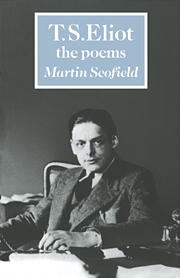Book contents
- Frontmatter
- Contents
- Acknowlegements
- Chronology
- Introduction
- 1 Aspects of the life of the poet
- 2 Early poetic influences and criticism, and Poems Written in Early Youth
- 3 Prufrock and Other Observations (1917)
- 4 Poetic theory and poetic practice
- 5 Poems (1920)
- 6 The Waste Land (1922)
- 7 From The Hollow Men (1925) to ‘Marina’ (1930)
- 8 Poetry, pattern and belief
- 9 From Coriolan (1931) to ‘Burnt Norton’ (1936)
- 10 ‘Burnt Norton’ (1936) and the pattern for Four Quartets
- 11 The wartime Quartets (1940–2)
- Notes
- Select bibliography
- Index
7 - From The Hollow Men (1925) to ‘Marina’ (1930)
Published online by Cambridge University Press: 18 January 2010
- Frontmatter
- Contents
- Acknowlegements
- Chronology
- Introduction
- 1 Aspects of the life of the poet
- 2 Early poetic influences and criticism, and Poems Written in Early Youth
- 3 Prufrock and Other Observations (1917)
- 4 Poetic theory and poetic practice
- 5 Poems (1920)
- 6 The Waste Land (1922)
- 7 From The Hollow Men (1925) to ‘Marina’ (1930)
- 8 Poetry, pattern and belief
- 9 From Coriolan (1931) to ‘Burnt Norton’ (1936)
- 10 ‘Burnt Norton’ (1936) and the pattern for Four Quartets
- 11 The wartime Quartets (1940–2)
- Notes
- Select bibliography
- Index
Summary
The Hollow Men, published in 1925, can be seen both as a continuation, in some ways a culmination, of the creative mood that produced The Waste Land, and, to a lesser extent, an attempt at a new beginning. Indeed, the conflict between these two tendencies, in which the former finally dominates, is what creates the tension in the poem. There are glimpses of a new imagery (the ‘perpetual star / Multifoliate rose’), and there is a new element of abstraction in Part V (‘the idea’ and ‘the reality’, ‘the conception’ and ‘the creation’, etc.), but the general mood of the poem is that of a kind of tense enervation which culminates in a shrill and desperate frivolity. But by 1930, with the publication of Ash-Wednesday, Eliot had reached a point of new religious orientation, and in ‘Marina’ a new and achieved sense of hope and expectation. This chapter will attempt to trace that progression through the poems.
Eliot said of Ash-Wednesday that like The Hollow Men it grew out of separate poems and that he gradually came to see it as a sequence. He felt that this was the way his poetry had often evolved. Part I of The Hollow Men (‘We are the hollow men’) was published separately in the winter of 1924–5. Part III (‘This is the dead land’) was published as the third of ‘Doris's Dream Songs’ in November 1924. Parts I, II and IV were published together in March 1925.
- Type
- Chapter
- Information
- T. S. Eliot: The Poems , pp. 137 - 166Publisher: Cambridge University PressPrint publication year: 1988



